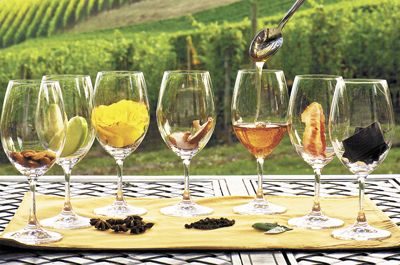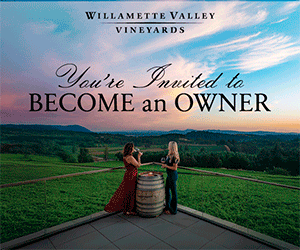Making Scents
of Wine

By Jennifer Cossey/Photos by Andrea Johnson
It is rumored that famed wine critic Robert Parker has his nose and palate insured for millions of dollars. Why, you may ask? So that he can detect elements like butter, green apple, clove, strawberry, lilac, earth or stone in his wine and tell us all about it? Why yes. Are these things really found in wine? Well … yes and no.
For some folks, wine simply smells like grape juice, while for others, it is a virtual cornucopia of sensory experiences. As a certified sommelier, I am frequently asked, “How do you smell all of those fragrant inferences in wine?” Or, “Do they really add berry juice to make it smell like berries?” To be brief, which I am never very good at, the answer is: no.
The art of sensory evaluation can be confusing to those not in the profession, who make a daily habit of picking out aromatic and taste profiles. So, as Oregon wine country welcomes a host of wine lovers from around the world for this year’s annual Thanksgiving Weekend festivities, I would humbly like to submit for your education and entertainment, a quick and easy guide to the deconstruction and appreciation of wine, along with some tasty bits of lightly perfumed data from some of the area’s top noses. Together, we can and will build your very own insurance-worthy nose and palate.
In order to successfully educate your sniffer to extract the descriptive elements in a wine, you must first spend some time smelling things, lots of things. I know it sounds silly, but trust me. Just as an athlete conditions his muscles to perform the way he needs them to in a long-distance race, a downfield pass or a golf swing, you must train your nose and brain to recognize specific scents.
Smell roses when they are in bloom, herbs when you pick them, candy as you unwrap it, bacon while it’s cooking. Essentially, smell everything. Take in the aroma and memorize the sensation. Try putting these sensory memories into your subconscious so when you detect something familiar or similar in a wine, you will recognize it immediately.
How we experience, taste and smell a wine is very personal, and the best techniques for an individual will simply be learned by trial and error. There are differing schools of thought in regards to the various methods, but there isn’t really one right way. However, for the purpose of this little manual, I have broken it down into a simple four-step process.
One very important note: it is best to leave the perfume and cologne in the bottle when going out to taste. I love perfume as much as the next woman, but when you wear it, the smell overpowers the aromas of the wine, masking them and hiding their beauty (much like a paper bag over the head of a fashion model). When you are at a winery or tasting event, that smell of your favorite perfume is infringing on not only your own but also everyone else’s ability, to fully appreciate the carefully crafted bouquet of scents in their glass.
Swirl it. Once the wine has been poured, give it a few swirls around your glass. The aromatic quality of a wine increases when you introduce more oxygen to it. The more you swirl, the more it opens up. Think of it as decanting (moving the wine from the bottle to a larger container to help open the wine up) in your glass.
If you aren’t comfortable swirling your wine out of fear you might splash it on your shirt or spill it on your neighbor, I suggest these two options. Option 1: Wear a black shirt Option 2: Take it slow. Start by swirling the glass with its base on the table. While holding the stem (not the bowl) of the glass, move the base around in either a clockwise or counterclockwise motion. Once you get comfortable with the feeling, lift the glass off the table and continue the motion.
Smell it. Stick your nose in the glass, partway. Warning: do not cup the glass all the way to your face. Depending on how vigorously you are swirling, there could be wine around the rim. If you bring the glass all the way to your face you may be left with a red ring around your cheeks and chin. This is not cute. It is definitely not the way to impress a date. But, it most certainly proves to be a quick and easy way to give your friends a good laugh at your expense.
Keeping your face at a safe distance, take a few long deep breaths or several short breaths in through your nose while sealing your lips together. Then simply pull the glass away and contemplate what you smell.
Describe it. Either to yourself (in your head) or your neighbor, verbalize what you smell. A handy tool is to mull over some of the categories (featured to the right), which can act as road signs to guide you along the way. You might not have something in every category, but it is helpful to access your sensory memory.
Taste it. Though 70 to 75 percent of flavor comes from what we smell, we do take a bit in from our taste buds. Those bits are: salt, sweet, sour, bitter and umami (savory). Pay attention to how a wine’s characteristics change once you have tasted it. At times, it won’t be much; while at other times, the wine smells very different from what it actually tastes like. If you plan to taste a lot of wines in one day don’t be embarrassed to spit out some of the wine or dump out what is left in your glass. At the end of the day — not to mention the next morning — you’ll be glad you did.
If you find you are drawing a complete blank during this process, here’s a quick trick: There are almost always notes of cherries (Bing, black, baked, etc.) in red wines and hints of apples (yellow, red delicious, green, baked, etc.) in whites. When all else fails, that can be a great place to start.
Whether your goal is to eventually blind taste with the best of them or to look like you know exactly what you are doing when out tasting with friends, this short course in aromatic detective work will give you the tools you need to accomplish it.
Don’t forget to contact your insurance agents about adding aromatic coverage to your policy, and most importantly, don’t lose your sense of humor while developing your sense of smell. It is, after all, just fermented grape juice.
FRUITS
Tree: Green apple, pear, quince
Stone: Peach, nectarine, apricot
Citrus: Lemon, orange, lime, grapefruit, mandarin
Red: Strawberry, cherry, raspberry, cranberry, pomegranate
Black & Blue: Black cherry, plum, cassis, blackberry
Tropical: Pineapple, mango, passion fruit, kiwi, banana
NON-FRUITS
Herbs: Basil, tarragon (dried); cilantro, lemon thyme, mint (fresh)
Spices: Nutmeg, clove, black pepper, cinnamon, sea salt
Vegetables: Bell pepper, olive, mushroom, grass, tomato
Nuts: Almond, hazelnut, pecan
Flowers: Lavender, violet, rose, honeysuckle, jasmine
Other: Tobacco, petrol, licorice, honey, chocolate, vanilla, cola, popcorn, leather, smoke
SNIFF NOTES
Don’t have the patience to train your own palate? Here is a cheat sheet for some of Oregon’s leading varietals. I harassed a few of the state’s leading noses, mostly winemakers and sommeliers, to see what they thought were the most common characteristics of our most treasured wines.
A caveat said best by sommelier Erica Landon, “These are very subjective [descriptors] based on the wine. Producer techniques, vintage, etc., all have dramatic effects on the characteristics.”
PINOT NOIR
Freshly turned earth, Cherry, Cranberry, Cola, Raspberry
PINOT GRIS
Apple, Pear, Lemon, White flowers, Almond
SYRAH
Plum, Black pepper, Blackberry, Blueberry, Lavender
RIESLING
Peach, Melon, Honeysuckle, Petrol, Wet Stone
VIOGNIER
Honeysuckle
Tropical fruit, Apricot, Honey, Peach
CHARDONNAY
Green apple, Citrus (lemon/lime), Baked brioche, Ginger, Yellow flowers
Thanks to Jerry Murray, winemaker Van Duzer Winery; Toni Ketrenos, sommelier and wine merchandiser for New Seasons Market; Anthony King, winemaker for Lemelson; Erica Landon, wine director for Bruce Carey Restaurants and The Heathman Restaurant; Jessica Mozeico-Blair, sales and winemaker for Et Fille Wines; Carrie Stigge, sommelier and direct sales manager for REX HILL and A to Z Wineworks; Jesse Lange, winemaker for Lange Winery; Gaironn Poole, sales consultant for Galaxy Wine Company; and Jim Prosser, winemaker for J.K. Carriere Wines.










